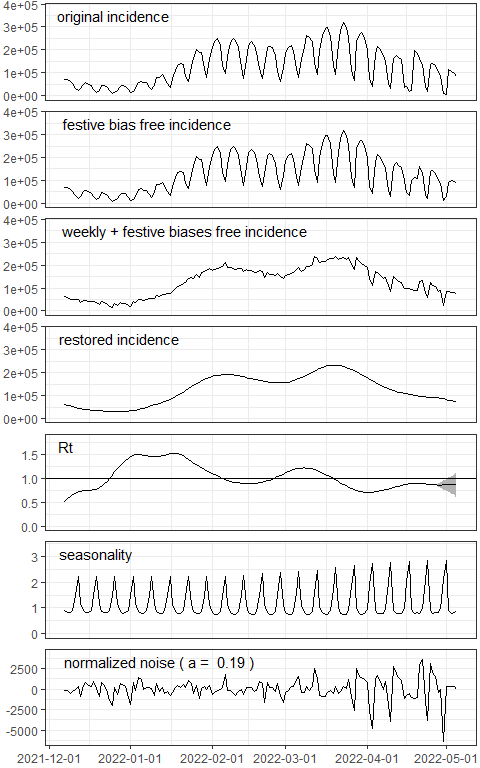Variational Techniques in Epidemiology.
EpiInvert (version 0.3.1, December 2022)
Using variational techniques we address some epidemiological problems as the incidence curve decomposition or the estimation of the functional relationship between epidemiological indicators. We also propose a learning method for the short time forecast of the trend incidence curve.
Vignettes of the main package functionalities
EpiInvert: an incidence curve decomposition by inverting the renewal equation.EpiInvertForecast: a learning method for the short time forecast of the trend incidence curve.EpiIndicators: estimation of the delay and ratio between epidemiological indicators.
We also present in Rt Comparison a comparative analysis of the methods : EpiInvert, EpiEstim, Wallinga-Teunis and EpiNow2.
EpiInvert Installation
You can install the development version of EpiInvert from GitHub with:
install.packages("devtools")
devtools::install_github("lalvarezmat/EpiInvert")
Example
We attach some required packages
library(EpiInvert)
library(ggplot2)
library(dplyr)
library(grid)
Loading data on COVID-19 daily incidence up to 2022-05-05 for France, Germany, the USA and the UK:
data(incidence)
tail(incidence)
#> date FRA DEU USA UK
#> 828 2022-04-30 49482 11718 23349 0
#> 829 2022-05-01 36726 4032 16153 0
#> 830 2022-05-02 8737 113522 81644 32
#> 831 2022-05-03 67017 106631 61743 35518
#> 832 2022-05-04 47925 96167 114308 16924
#> 833 2022-05-05 44225 85073 72158 12460
Loading some festive days for the same countries:
data(festives)
head(festives)
#> USA DEU FRA UK
#> 1 2020-01-01 2020-01-01 2020-01-01 2020-01-01
#> 2 2020-01-20 2020-04-10 2020-04-10 2020-04-10
#> 3 2020-02-17 2020-04-13 2020-04-13 2020-04-13
#> 4 2020-05-25 2020-05-01 2020-05-01 2020-05-08
#> 5 2020-06-21 2020-05-21 2020-05-08 2020-05-25
#> 6 2020-07-03 2020-06-01 2020-05-21 2020-06-21
Executing EpiInvert using Germany data:
res <- EpiInvert(incidence$DEU,"2022-05-05",festives$DEU)
Plotting the results:
EpiInvert_plot(res)

For a detailed description of EpiInvert outcomes see the EpiInvert vignette.